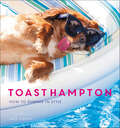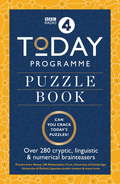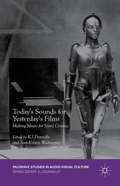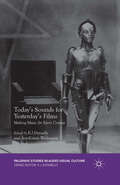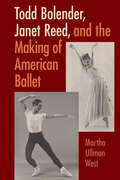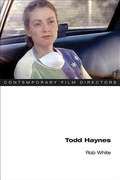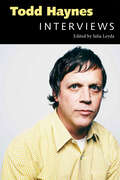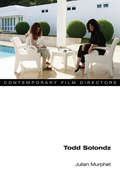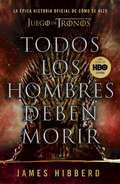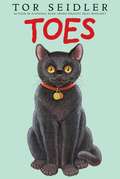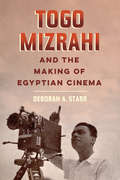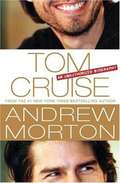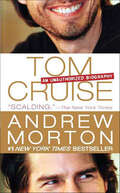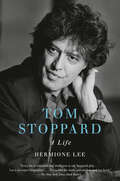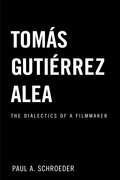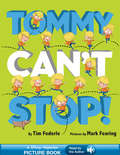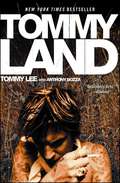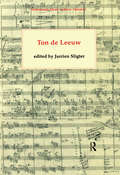- Table View
- List View
ToastHampton: How to Summer in Style
by Katie SturinoA delightful and colorful high-fashion romp featuring Toast, the world’s first supermodel dog.She’s graced the pages of the New York Times and Us Weekly, and has appeared on Good Morning America and the Today show. She’s starred in designer Karen Walker’s advertising campaign, and pens her own weekly column in PeopleMagazine: Pets. Her jet-setting friends include Karlie Kloss, Reese Witherspoon, Jane Lynch, and, of course, her Internet celebrity dad, The Fat Jew. She has hundreds of thousands of fans following her every move on Instagram. She’s Toast, the puppymill rescue Cavalier King Charles Spaniel whose toothless grin and ever-present tongue have become today’s hottest style sensation.Now, fans can enjoy their favorite fashionista canine in ToastHampton, a collection of divine photographs that capture Toast shaking her auburn fur as she models big-name brands in the tony Hamptons.Whether she’s lounging on the sand, frolicking through a seaside meadow, dipping her paws in the sparkling sea, or striking one of her famous poses, Toast always sports the unique, sophisticated style that has melted fans’ hearts worldwide . . . and keeps them begging for more.
Today Programme Puzzle Book: The puzzle book of 2018
by BBC***The best intelligent puzzle book on the market*** Fiendish fun! - The Times Can YOU solve the Puzzle for Today?Tackle the conundrums that have been frustrating and confounding the nation, with the first official book from Radio 4's Today programme.Put your deciphering skills and mental agility to the test with over 280 cryptic, numerical and linguistic brainteasers from Britain's best-loved radio programme, set by the world's ultimate puzzle masters.So, challenge your grey matter and hone your reasoning and logic skills with the brainteasers that get the nation's (and many world leaders') synapses firing every morning at 6.50am.With a foreword by Sarah Sands, editor of the Today programme.Introductions to each chapter by Tom Feildon, the BBC Science Editor.Chapters:Never Aired Puzzles Common-sense ConundrumsFlags, Capitals & NationsMaths & LanguageFurther MathsBBC Today Presenters' PuzzlesCelebrity SettersChristmas Crackers Want to take on the hardest, most fiendish puzzles out there created by the greatest minds around the world? If The Ordnance Survey Puzzle Book, The GCHQ Puzzle Book and Tim Peake's Astronaut Selection Test Book were no match for you, pit your wit against TODAY.
Today Programme Puzzle Book: The puzzle book of 2018
by Bbc***The puzzle book of 2018***The Today Programme Puzzle Book is perfect for fans of Bletchley Park Brainteasers and The GCHQ Puzzle Book. Which is the only letter of the alphabet not to appear in the name of any US state? Can YOU solve the Puzzle for Today?Tackle the conundrums that have been frustrating and confounding the nation on Radio 4's Today programme.The Today Programme Puzzle Book challenges you with over 280 cryptic, linguistic & numerical brainteasers designed by the greatest puzzles masters around the world from Mensa, UK Mathematics Trust, University of Cambridge, University of Oxford, Japanese puzzle masters & many more.Chapters include:Common-sense ConundrumsFlags, Capitals & NationsMaths & LanguageFurther MathsNew PuzzlesBBC Today Presenters' PuzzlesCelebrity SettersChristmas CrackersSo, challenge your grey matter and hone your reasoning and logic skills with the brainteasers that manage to get the nation's synapses firing every morning. With a foreword by Sarah Sands, editor of the Today programme.Introductions to each chapter by Tom Feildon, the BBC Science Editor.[Answer: The letter Q]
Today's Sounds for Yesterday's Films: Making Music for Silent Cinema (Palgrave Studies in Audio-Visual Culture)
by K. J. Donnelly Ann-Kristin WallengrenIn recent years, there has been something of an explosion in the performance of live music to silent films. There is a wide range of films with live and new scores that run from the historically accurate orchestral scores to contemporary sounds by groups such as Pet Shop Boys or by experimental composers and gothic heavy metal bands. It is no exaggeration to claim that music constitutes a bridge between the old silent film and the modern audience; music is also a channel for non-scholarly audiences to gain an appreciation of silent films. Music has become a means both for musicians and audiences to understand this bygone film art anew. This book is the first of its kind in that it aims to bring together writings and interviews to delineate the culture of providing music for silent films. It not only has the character of a scholarly work but is also something of a manual in that it discusses how to make music for silent films.
Today's Sounds for Yesterday's Films: Making Music for Silent Cinema (Palgrave Studies in Audio-Visual Culture)
by K. J. Donnelly Ann-Kristin WallengrenIn recent years, there has been something of an explosion in the performance of live music to silent films. There is a wide range of films with live and new scores that run from the historically accurate orchestral scores to contemporary sounds by groups such as Pet Shop Boys or by experimental composers and gothic heavy metal bands. It is no exaggeration to claim that music constitutes a bridge between the old silent film and the modern audience; music is also a channel for non-scholarly audiences to gain an appreciation of silent films. Music has become a means both for musicians and audiences to understand this bygone film art anew. This book is the first of its kind in that it aims to bring together writings and interviews to delineate the culture of providing music for silent films. It not only has the character of a scholarly work but is also something of a manual in that it discusses how to make music for silent films.
Today: A History of our World through 60 years of Conversations & Controversies
by Edward StourtonEdited by Edward StourtonForewords by Nick Robinson & Martha KearneyWith an introduction by Sarah Sands, editor of the Today programme.In an era of fake news, echo chambers and new fault lines in global politics, millions of listeners turn to BBC Radio 4's Today programme each morning to help them make sense of the world around them. The first ever book from the iconic programme marks six decades of BBC Radio 4's Today programme with sixty world changing stories as they were broadcast. Covering war, rebellion and political transformation, to significant changes in culture, society, and the scientific world, the book explores events as they happened, and how they changed the world around us.From the fall of the Berlin Wall and the anti-apartheid movement to 9/11 and the Rise of Islamic State, from the Rushdie affair to the emergence of Brit Art and from space exploration to the tomorrow's world of artificial intelligence and machine learning. Key figures within the book include Harold Wilson, Margaret Thatcher, Stephen Hawking, Tracey Emin and Barack Obama. Chapters include:Chapter 1: Rebellion, Revolution and ProtestChapter 2: Britain's Political LandscapeChapter 3: War, Conflict and SecurityChapter 4: Art, Culture and SportChapter 5: Social ChangeChapter 6: The Natural World, Science and TechnologyToday is the sound of history being made - live on air.Also available in Audio and Ebook.
Today: A History of our World through 60 years of Conversations & Controversies
by Sarah SandsToday is the sound of history being made - live on air.In an era of fake news, echo chambers and new fault lines in global politics, millions of listeners turn to BBC Radio 4's Today programme each morning to help them make sense of the world around them. The first ever book from the iconic programme marks six decades of BBC Radio 4's Today programme with sixty world changing stories as they were broadcast. Covering war, rebellion and political transformation, to significant changes in culture, society, and the scientific world, the book explores events as they happened, and how they changed the world around us.From the fall of the Berlin Wall and the anti-apartheid movement to 9/11 and the Rise of Islamic State, from the Rushdie affair to the emergence of Brit Art and from space exploration to the tomorrow's world of artificial intelligence and machine learning. Key figures within the book include Harold Wilson, Margaret Thatcher, Stephen Hawking, Tracey Emin and Barack Obama. Chapters include:Chapter 1: Rebellion, Revolution and ProtestChapter 2: Britain's Political LandscapeChapter 3: War, Conflict and SecurityChapter 4: Art, Culture and SportChapter 5: Social ChangeChapter 6: The Natural World, Science and TechnologyAlso available in Audio and Ebook.Edited by Edward StourtonForewords by Nick Robinson & Martha KearneyWith an introduction by Sarah Sands, editor of the Today programme.Shortlisted for the 2019 FutureBook of the Year award
Today: A History of our World through 60 years of Conversations & Controversies
by Sarah SandsToday is the sound of history being made - live on air.In an era of fake news, echo chambers and new fault lines in global politics, millions of listeners turn to BBC Radio 4's Today programme each morning to help them make sense of the world around them. The first ever book from the iconic programme marks six decades of BBC Radio 4's Today programme with sixty world changing stories as they were broadcast. Covering war, rebellion and political transformation, to significant changes in culture, society, and the scientific world, the book explores events as they happened, and how they changed the world around us.From the fall of the Berlin Wall and the anti-apartheid movement to 9/11 and the Rise of Islamic State, from the Rushdie affair to the emergence of Brit Art and from space exploration to the tomorrow's world of artificial intelligence and machine learning. Key figures within the book include Harold Wilson, Margaret Thatcher, Stephen Hawking, Tracey Emin and Barack Obama. Chapters include:Chapter 1: Rebellion, Revolution and ProtestChapter 2: Britain's Political LandscapeChapter 3: War, Conflict and SecurityChapter 4: Art, Culture and SportChapter 5: Social ChangeChapter 6: The Natural World, Science and TechnologyAlso available in Audio and Ebook.Edited by Edward StourtonForewords by Nick Robinson & Martha KearneyWith an introduction by Sarah Sands, editor of the Today programme.Shortlisted for the 2019 FutureBook of the Year award
Todd Bolender, Janet Reed, and the Making of American Ballet
by Martha WestMartha Ullman West illustrates how American ballet developed over the course of the twentieth century from an aesthetic originating in the courts of Europe into a stylistically diverse expression of a democratic culture. West places at center stage two artists who were instrumental to this story: Todd Bolender and Janet Reed. Lifelong friends, Bolender (1914–2006) and Reed (1916–2000) were part of a generation of dancers who navigated the Great Depression, World War II, and the vibrant cultural scene of postwar New York City. They danced in the works of choreographers Lew and Willam Christensen, Eugene Loring, Agnes de Mille, Catherine Littlefield, Ruthanna Boris, and others who West argues were just as responsible for the direction of American ballet as the legendary George Balanchine and Jerome Robbins. The stories of Bolender, Reed, and their contemporaries also demonstrate that the flowering of American ballet was not simply a New York phenomenon. West includes little-known details about how Bolender and Reed laid the foundations for Seattle’s Pacific Northwest Ballet in the 1970s and how Bolender transformed the Kansas City Ballet into a highly respected professional company soon after. Passionate in their desire to dance and create dances, Bolender and Reed committed their lives to passing along their hard-won knowledge, training, and work. This book celebrates two unsung trailblazers who were pivotal to the establishment of ballet in America from one coast to the other.
Todd Haynes (Contemporary Film Directors)
by Rob WhiteTodd Haynes's films are intricate and purposeful, combining the intellectual impact of art cinema with the emotional accessibility of popular genres. They are also underpinned by a serious commitment to feminism and queer theory. From his 1985 student film about Arthur Rimbaud to his shapeshifting portrait of Bob Dylan in I'm Not There (2007) and the riveting HBO miniseries Mildred Pierce (2011), Haynes has made films whose complex weave of stories and characters reveals dark, painful intensities. His taste for narrative experimentation and pastiche is haunted by anguish. Rob White's highly readable book, which includes a major new interview with Haynes, is the first comprehensive study of the director's work. Special attention is paid to the fascination with music culture (from the Carpenters to glam rock) and to the rich pattern of allusions to, or affinity with, predecessor filmmakers (Fassbinder, Ophuls, Sirk, and many more). But White's chief concern is the persistence of a queer impulse to explore social coercion and the possibility that there may be some way of escaping its cruelty.
Todd Haynes: Interviews (Conversations with Filmmakers Series)
by Julia LeydaA pioneer of the New Queer Cinema, Todd Haynes (b. 1961) is a leading American independent filmmaker. Whether working with talking dolls in a homemade short (Superstar: The Karen Carpenter Story) or with Oscar-winning performers in an HBO miniseries (Mildred Pierce), Haynes has garnered numerous awards and nominations and an expanding fan base for his provocative and engaging work. In all his films, Haynes works to portray the struggles of characters in conflict with the norms of society. Many of his movies focus on female characters, drawing inspiration from genres such as the woman's film and the disease movie (Far from Heaven and Safe); others explore male characters who transgress sexual and other social conventions (Poison and Velvet Goldmine). The writer-director has drawn on figures such as Karen Carpenter, David Bowie, Iggy Pop, and Bob Dylan in his meditations on American and British music, celebrity, and the meaning of identity. His 2007 movie I'm Not There won a number of awards and was notable for Haynes's decision to cast six different actors (one of whom was a woman) to portray Dylan. Gathering interviews from 1989 through 2012, this collection presents a range of themes, films, and moments in the burgeoning career of Todd Haynes.
Todd Solondz (Contemporary Film Directors)
by Julian MurphetFilms like Welcome to the Dollhouse and Happiness established Todd Solondz as independent cinema's premier satirist. Blending a trademark black humor into atmospheres of grueling bleakness, Solondz repeatedly takes moviegoers into a bland suburban junk space peopled by the damaged, the neglected, and the depraved.Julian Murphet appraises the career of the controversial, if increasingly ignored, indie film auteur. Through close readings and a discussion with the director, Murphet dissects how Solondz's themes and techniques serve stories laden with hot-button topics like pedophilia, rape, and family and systemic cruelty. Solondz's uncompromising return to the same motifs, stylistic choices, and characters reject any idea of aesthetic progression. Instead, he embraces an art of diminishing returns that satirizes the laws of valuation sustaining what we call cinema. It also reflects both Solondz's declining box office fortunes and the changing economics of independent film in an era of financial contraction.
Todos los hombres deben morir: La épica historia oficial de cómo se hizo Juego de tronos
by James HibberdLa épica historia oficial, avalada por HBO, de cómo se hizo la exitosa serie de televisión Juego de tronos. «Todo está aquí: cómo comenzó, cómo terminó, dragones y lobos huargos, lo que pasó delante de las cámaras y entre bambalinas, los triunfos y tropiezos, las decisiones difíciles, las encrucijadas, los porqués. Actores, directores, showrunners, productores, ejecutivos e incluso a mí... Todos los hombres deben morir lo tiene todo, todo lo que siempre has querido saber. Juego de tronos fue un viaje apasionante. Todos los hombres deben morir es una lectura apasionante.» George R.R. Martin Se suponía que era imposible. Cuando George R. R. Martin creó su saga best seller de novelas fantásticas titulada «Canción de hielo y fuego», lo hizo con la idea de confinarla únicamente a los inmensos límites de su imaginación dada la dificultad que conllevaría el rodaje. Sin embargo, un par de guionistas primerizos, junto con HBO, lograron adaptar el épico relato de Martin y el resultado es de sobras conocido: muchos hemos visto las ocho temporadas de la galardonada serie que llegaron a continuación. A pesar del éxito, siempre bien documentado, todavía nos queda una historia por conocer sobre Juego de tronos: los entresijos de los trece años de lucha para sacar adelante este extraordinario fenómeno. En Todos los hombres deben morir, el premiado periodista James Hibberd nos ofrece, por primera vez y en exclusiva, la crónica de la aclamadísima serie de HBO Juego de tronos: desde la reunión inicial del equipo creativo hasta la puesta en escena del final de la serie, pasando por todas las épicas batallas que se libraron delante y detrás de las cámaras y que también se convirtieron en leyenda. Este esperado libro contiene más de cincuenta entrevistas inéditas y fotos espectaculareso poco conocidas del rodaje. Además, nos da acceso a la increíble experiencia de los productores, el reparto y el equipo que consiguió convertir las novelas de George R. R. Martin en el mayor fenómeno televisivo del mundo.
Toes
by Tor SeidlerAfter getting lost on Halloween night when he is only a few months old, an intelligent seven-toed kitten makes his way into the life of a struggling musician.
Togo Mizrahi and the Making of Egyptian Cinema (University of California Series in Jewish History and Cultures #1)
by Prof. Deborah A. StarrA free open access ebook is available upon publication. Learn more at www.luminosoa.org. In this book, Deborah A. Starr recuperates the work of Togo Mizrahi, a pioneer of Egyptian cinema. Mizrahi, an Egyptian Jew with Italian nationality, established himself as a prolific director of popular comedies and musicals in the 1930s and 1940s. As a studio owner and producer, Mizrahi promoted the idea that developing a local cinema industry was a project of national importance. Togo Mizrahi and the Making of Egyptian Cinema integrates film analysis with film history to tease out the cultural and political implications of Mizrahi’s work. His movies, Starr argues, subvert dominant notions of race, gender, and nationality through their playful—and queer—use of masquerade and mistaken identity. Taken together, Mizrahi’s films offer a hopeful vision of a pluralist Egypt. By reevaluating Mizrahi’s contributions to Egyptian culture, Starr challenges readers to reconsider the debates over who is Egyptian and what constitutes national cinema.
Tokyo Boogie-Woogie: Japan's Pop Era and Its Discontents
by Hiromu NagaharaEmerging in the 1920s, the Japanese pop scene gained a devoted following, and the soundscape of the next four decades became the audible symbol of changing times. In the first English-language history of this Japanese industry, Hiromu Nagahara connects the rise of mass entertainment with Japan’s transformation into a postwar middle-class society.
Tom Cruise: An Unauthorized Biography
by Andrew MortonA riveting portrait of the real Tom Cruise - his work, love life, marriages and religion - from a master at uncovering the true story behind the public face of celebrity.
Tom Cruise: An Unauthorized Biography
by Andrew MortonAndrew Morton uncovers the true story of the biggest celebrity of our age. Everyone knows Tom Cruise—or at least what he wants us to know. We know that the man behind the smile overcame a tough childhood to star in astonishing array of blockbusters: Top Gun, Rain Man, Born on the Fourth of July, A Few Good Men, Jerry Maguire, several Mission: Impossible movies, and more. We know he has taken artistic chances, too, earning him three Academy Award and Golden Globe nominations. But beyond that, the picture becomes a bit less clear…We know that Tom is a devoted follower of the Church of Scientology. We know that, despite persistent rumors about his sexuality, he has been married to Mimi Rogers, Nicole Kidman, and Katie Holmes. But it was not until he jumped on Oprah's couch to proclaim his love for Katie and denounced Brooke Shields for turning to the "Nazi science" of psychiatry that we began to realize how much we did not know about the charming, hardworking star. For all the headlines and the rumors, the real Tom Cruise has remained surprisingly hidden—until now.
Tom Stoppard: A Life
by Hermione LeeOne of our most brilliant biographers takes on one of our greatest living playwrights, drawing on a wealth of new materials and on many conversations with himOne of our most brilliant biographers takes on one of our greatest living playwrights, drawing on a wealth of new materials and on many conversations with himTom Stoppard is a towering and beloved literary figure. Known for his dizzying narrative inventiveness and intense attention to language, he deftly deploys art, science, history, politics, and philosophy in works that span a remarkable spectrum of literary genres: theater, radio, film, TV, journalism, and fiction. His most acclaimed creations--Rosencrantz and Guildenstern are Dead, The Real Thing, Arcadia, The Coast of Utopia, Shakespeare in Love--remain as fresh and moving as when they entranced their first audiences.Born in Czechoslovakia, Stoppard escaped the Nazis with his mother and spent his early years in Singapore and India before arriving in England at age eight. Skipping university, he embarked on a brilliant career, becoming close friends over the years with an astonishing array of writers, actors, directors, musicians, and political figures, from Peter O'Toole, Harold Pinter, and Stephen Spielberg to Mick Jagger and Václav Havel. Having long described himself as a "bounced Czech," Stoppard only learned late in life of his mother's Jewish family and of the relatives he lost to the Holocaust.Lee's absorbing biography seamlessly weaves Stoppard's life and work together into a vivid, insightful, and always riveting portrait of a remarkable man.
Tomas Gutierrez Alea: The Dialectics of a Filmmaker
by Paul A. SchroederFirst Published in 2003. Routledge is an imprint of Taylor & Francis, an informa company.
Tommy Can't Stop!: A Read-Along Book (Hyperion Picture Book with Audio (eBook))
by Tim FederleTommy bounces, and he leaps. Tommy clomps, and he bulldozes. Nothing tires Tommy out, and his family can't keep up! But then his sister has an idea: could tap class be just right for Tommy? This exuberant picture book, written by Broadway dancer Tim Federle, with illustrations by Mark Fearing, stars one very energetic kid who finally finds his place in the spotlight. Follow along with word-for-word narration.
Tommyland
by Tommy LeeI am Tommy Lee, born Thomas Lee Bass in Athens, Greece, on October 3, 1962, and raised in a suburb of California by an American father and a Greek mother. At seventeen, I joined Mötley Crüe and we became one of the baddest-ass rock bands in history. We sold over 40 million albums, we wreaked havoc, we scared parents, and we titillated too many fathers' daughters. I've been married three times: once for just a few days to a Penthouse Pet, for seven years to Heather Locklear, and then for five years to Pamela Anderson, with whom I have two beautiful sons. I've gotten into a lot of fights and I've been to jail a few times.But this book isn't your typical journey in a straight line from day one to day now. I'm more interested in revealing what's most important about my life, like how I cook my steaks; what I think of the tabloids, the truth, my ex-wives, my ex-band, my music; and what an innocent observer might find hanging around my house any given Sunday. You'll get plenty of facts and I'll tell you a story, but my real mission here is to paint you a picture of my life. I want to show you how my memories smell.I'd like to get into it now, so please take your seats. I advise you to keep your arms and legs inside the car at all times. If you have a pacemaker, a heart condition, or if you are pregnant or too damn short to reach the safety bar, I ask that you turn back immediately. Those with weak stomachs, strict morals, or chronic indigestion should put the book down now. For the rest of you, there's one truth that's real across the board: What you send out is what you get back. Send out the good, people, and it will come back to you. There's another thing I've learned over the years, in court, in fights, and in arguments with people I love: There isn't one truth, there are many. This book is my truth.NOTE: THE EBOOK DOES NOT INCLUDE PHOTOGRAPHS THAT APPEAR IN THE PRINT EDITIONS.
Tomorrow Is a Chance to Start Over
by Hilary GristWinner of:2015 National Association of Parenting Publications, Gold Award2015 Parents' Choice RecommendedNominee:2015 Canadian Folk Music Award, Best Children's AlbumA fresh, original project that will appeal to young parents who are fans of musical artists Feist or Norah Jones Ira and Isabelle, who live in a little red house by the sea, decide one night to escape the sound of the city's beeping cars and sail off to a faraway land where they learn from a new friend—a robin with a soft voice—that dreams really can come true. The book contains an audio CD that features the narrated story as well as 10 original heartwarming dream songs, and an ethereal rendition of Johannes Brahms' classic "Cradle Song."
Ton de Leeuw (Netherlands Music Archive #Vol. 1.)
by John Lydon Jurrien SligterFirst Published in 1996. Routledge is an imprint of Taylor & Francis, an informa company.
